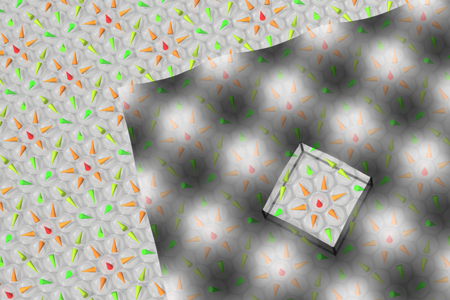Forschungszentrum Jülich’s physicists in collaboration with the universities of Hamburg and Kiel have developed radial spiral magnetic structures on the material surface rather than inside bulk materials.
The discovery of a stable magnetic lattice of skyrmions can form the foundation for generating efficient and compact information storage units to be used in information technology. These spiral structures, each comprising only 15 atoms, were developed as a single atomic iron layer on iridium.
 "Physicists at Forschungszentrum Jülich and the universities of Kiel and Hamburg are the first to discover stable magnetic skyrmions on a surface as opposed to in bulk materials. The tiny cycloidal spirals, made up of just 15 atoms with their spins, form a regular lattice. The diagram shows simulations of magnetic measurements with the aid of spin-polarised scanning tunnelling microscopy in black and white. The orange, red and green arrows show the upward or downward orientation of the spins. The cube-shaped “peephole” designates a single skyrmion. Source: University of Hamburg"
"Physicists at Forschungszentrum Jülich and the universities of Kiel and Hamburg are the first to discover stable magnetic skyrmions on a surface as opposed to in bulk materials. The tiny cycloidal spirals, made up of just 15 atoms with their spins, form a regular lattice. The diagram shows simulations of magnetic measurements with the aid of spin-polarised scanning tunnelling microscopy in black and white. The orange, red and green arrows show the upward or downward orientation of the spins. The cube-shaped “peephole” designates a single skyrmion. Source: University of Hamburg"
The presence of magnetic skyrmions was identified around 20 years back, but was proved only in 2009. Researchers from the Technische Universität München (TUM) had discovered magnetic lattices of vortices in manganese silicon that can exist in a weak magnetic field. However, the recently discovered spiral structures by scientists at Hamburg, Kiel, and Jülich do not require any external magnetic field and were placed on the material surface rather than inside the material. The diameter of these structures measured only few atoms, thereby making them smaller than the present skyrmions by at least one order-of-magnitude.
Previously in 2007, the same research team identified a unique form of magnetic order in a thin film of manganese on tungsten surface and developed the wave-like structures with the help of Dzyaloshinskii-Moriya interaction. Similar interaction was needed for the creation of spiral-shaped skyrmions.
In order to examine the existence of a different type of magnetic state, the scientists first prepared a single atom chromium layer on iridium. Since this effort failed, they made use of other metals. By studying iron on iridium with the help of spin-polarized scanning tunneling microscope, the scientists at the University of Hamburg observed uniform magnetic patterns that were inconsistent with the metal surface’s crystalline structure.
This resulted in a model that described the spin alignment structure combining three interactions that include the non-linear interaction relating four spins, the conventional interaction between spins, and the chiral Dzyaloshinskii-Moriya interaction. This model shall influence magnetic structures located on surfaces selectively in future.
Source: http://www.fz-juelich.de/